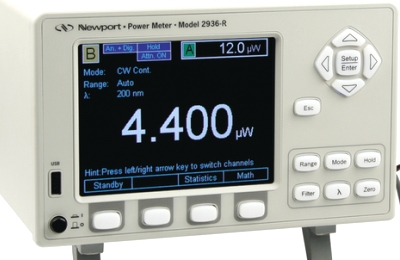
|
|
The Newport 2936-R High-Performance Optical Power/Energy Meter, Dual Channel, RoHS is one of the most sophisticated optical meters. For applications requiring measurement of low-power, high-power or energy of continuous or pulsed light sources, Newport’s 2936-R instrument has broken the barrier of temporal measurement performance with calibrated results. This series of power/energy meters have the ability to handle repetition-rates of up to 10 kHz at a sampling rate of 250 kHz. This means that even reasonably high speed dynamical phenomena can be seen using the meter, eliminating a need for an oscilloscope in many cases. Pulse, peak-to-peak and DC source measurements can be displayed in units of W, dBm, dB, J, A, V and Sun (depending on the detector model). Simultaneous measurements of a variety of light sources operating at different power levels and wavelengths can be performed with our Dual-Channel 2936-R Optical Meter. Specifications. Compatible, Hot-swappable Newport Detectors: 918D, 818P, 818E, and 818 detectors with DB15 connectors. Sampling Rate: 250 kHz. Measurement Rate: 10 kHz (CW measurements, semiconductor detectors). Display Refresh Rate: 20 Hz. Maximum Rep Rate: 10 (10 kHz for Pyroelectric and thermopile, 20 kHz for Photodiode detectors, peak to peak power). Resolution (% of Full Scale): 0.0004. Accuracy (%): ±0.2 % for CW, ±1 % for Peak to Peak, Pulse to Pulse, and Integration Mode. Frequency Measurement Range: 1 Hz to 250 kHz. Maximum Detector Input Current: 25 mA. Maximum Detector Input Voltage: 130 V. Analog Output (User Selectable): 0-1 V, 0-2 V, 0-5 V or 0-10 V (user selectable output impedance). Analog Output Bandwidth: DC-500 kHz (Photodiode), DC-1.9 MHz (Thermo or Pyro). Display Type: 5.7” Graphical TFT LCD, 1/4 VGA. Display Formats: 20 mm Numeric, Bar Chart, Min/Max Bar, Statistics. Communication Interfaces: USB and RS-232.
|